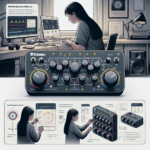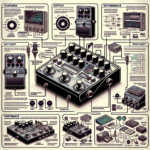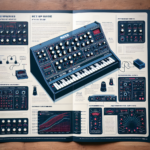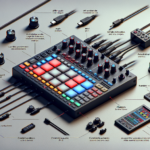Roland GI-20: Comprehensive Guide to Features, Setup, and Performance
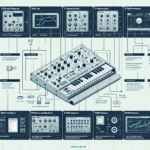
Introduction
The Roland GI-20 is a versatile MIDI controller designed to bridge the gap between traditional guitar playing and modern digital music production. This device allows guitarists to convert their guitar signals into MIDI data, enabling them to control synthesizers, virtual instruments, and other MIDI-compatible devices. Targeted at both amateur and professional musicians, the Roland GI-20 offers a unique way to expand the creative possibilities of guitarists.
Roland is a well-established brand in the music industry, known for its innovative and high-quality musical instruments and equipment. With a reputation for reliability and cutting-edge technology, Roland has been a trusted name among musicians for decades.
Key Features Overview:
- Guitar-to-MIDI conversion
- High-speed tracking
- Compatibility with various DAWs
- Customizable MIDI settings
- Durable and portable design
Design and Build Quality
Physical Design
The Roland GI-20 boasts a compact and sleek design, making it an unobtrusive addition to any setup. Measuring approximately 8.5 x 6.5 x 2 inches and weighing around 2 pounds, it is lightweight and easy to handle. The device is constructed from high-quality plastic, ensuring durability without adding unnecessary weight.
Portability
Given its compact size and lightweight build, the Roland GI-20 is highly portable. It can easily fit into a gig bag or backpack, making it an excellent choice for musicians who need a reliable MIDI controller on the go.
Durability
The build quality of the Roland GI-20 is impressive, with a sturdy construction that can withstand regular use. The high-quality plastic casing protects the internal components, ensuring longevity even with frequent transportation and use in various environments.
Setup and Configuration
Initial Setup
Setting up the Roland GI-20 is straightforward. Follow these steps to get started:
- Connect your guitar to the GI-20 using a 13-pin GK cable.
- Connect the GI-20 to your computer or MIDI device using a USB or MIDI cable.
- Power on the GI-20 and your computer or MIDI device.
- Ensure your guitar is properly tuned for optimal tracking.
Software Installation
To fully utilize the Roland GI-20, you may need to install specific drivers or software. Follow these steps:
- Visit the Roland website and navigate to the support section.
- Download the appropriate drivers for your operating system.
- Install the drivers by following the on-screen instructions.
- Restart your computer to complete the installation process.
Compatibility
The Roland GI-20 is compatible with a wide range of operating systems and DAWs. Supported operating systems include Windows and macOS. Popular DAWs such as Ableton Live, FL Studio, Logic Pro, and Cubase are fully compatible with the GI-20, allowing seamless integration into your existing setup.
Features and Functionality
Key Features
The Roland GI-20 offers several key features that make it a standout MIDI controller:
- Guitar-to-MIDI Conversion: Converts guitar signals into MIDI data for controlling virtual instruments and synthesizers.
- High-Speed Tracking: Ensures accurate and responsive tracking of guitar notes.
- Customizable MIDI Settings: Allows users to adjust MIDI parameters to suit their preferences.
- Multiple Output Options: Includes USB and MIDI outputs for versatile connectivity.
Customizability
The Roland GI-20 offers extensive customization options, allowing users to tailor the device to their specific needs. MIDI mapping and function assignment can be easily adjusted through the device’s interface or accompanying software. This flexibility ensures that the GI-20 can adapt to various playing styles and musical genres.
Unique Functions
One of the unique functions of the Roland GI-20 is its ability to split the guitar’s signal into multiple MIDI channels. This feature allows users to assign different MIDI instruments to different strings, creating complex and layered sounds. Additionally, the GI-20 includes a built-in tuner and metronome, providing essential tools for practice and performance.
Integration with DAWs
The Roland GI-20 integrates seamlessly with popular DAWs, offering plug-and-play functionality with minimal setup required. Users can easily assign MIDI channels and control parameters within their DAW, allowing for a smooth workflow and enhanced creative possibilities.
Advanced Features
The Roland GI-20 includes several advanced features that cater to experienced musicians. These include aftertouch sensitivity, which allows for expressive playing, and an arpeggiator function that can add rhythmic complexity to performances. The device also supports chord modes, enabling users to trigger complex chords with a single note.
Performance
Latency and Responsiveness
The Roland GI-20 excels in terms of latency and responsiveness. The high-speed tracking ensures that notes are accurately detected and converted into MIDI data with minimal delay. This responsiveness is crucial for live performances and studio recordings, where timing and precision are essential.
Real-World Usage
In practical scenarios, the Roland GI-20 performs admirably. Whether used in a live performance or a studio session, the device consistently delivers accurate and reliable MIDI conversion. Musicians can confidently use the GI-20 to control virtual instruments, add layers to their compositions, and experiment with new sounds.
User Experience
User feedback for the Roland GI-20 is overwhelmingly positive. Musicians appreciate the device’s ease of use, reliability, and versatility. The intuitive interface and robust build quality contribute to a positive user experience, making the GI-20 a popular choice among guitarists looking to expand their creative horizons.
Applications and Use Cases
Beginner vs. Professional Use
The Roland GI-20 is suitable for both beginners and professionals. Its user-friendly interface and straightforward setup make it accessible to novice musicians, while its advanced features and customization options cater to the needs of experienced players.
Studio Use
In a studio environment, the Roland GI-20 is an invaluable tool for music production and recording. It allows guitarists to easily integrate their instrument into digital workflows, enabling them to control virtual instruments, create complex arrangements, and experiment with new sounds.
Live Performance
The Roland GI-20 performs exceptionally well in live settings. Its high-speed tracking and low latency ensure that notes are accurately detected and converted in real-time, allowing for seamless integration into live performances. The device’s portability and durability make it a reliable choice for gigging musicians.
Specific Genres
The Roland GI-20 excels in various musical genres, including EDM, hip-hop, and classical music. Its ability to control virtual instruments and create complex arrangements makes it a versatile tool for electronic music producers. In hip-hop, the GI-20 can be used to trigger samples and create unique beats. Classical musicians can use the device to experiment with new sounds and expand their creative possibilities.
Pros and Cons
Pros:
- High-speed tracking and low latency
- Extensive customization options
- Seamless integration with popular DAWs
- Durable and portable design
- Suitable for both beginners and professionals
Cons:
- Requires a 13-pin GK cable, which may not be included
- Limited to guitarists; not suitable for other instruments
- Some advanced features may have a learning curve
Common Issues and Troubleshooting
Known Issues
Some users have reported occasional tracking issues, particularly with fast or complex playing styles. Additionally, the device may require periodic calibration to maintain optimal performance.
Troubleshooting Tips
- Ensure your guitar is properly tuned and intonated.
- Regularly calibrate the device to maintain accurate tracking.
- Check all connections and cables for any signs of wear or damage.
- Update the device’s firmware and drivers to the latest versions.
Customer Support
Roland’s customer support is generally well-regarded, with responsive and knowledgeable representatives available to assist with any issues. The brand also offers extensive online resources, including user manuals, FAQs, and troubleshooting guides.
Comparisons with Similar Controllers
Competitor Comparison
When compared to similar MIDI controllers from other brands, the Roland GI-20 stands out for its high-speed tracking and extensive customization options. Competitors such as the Fishman TriplePlay offer similar functionality but may lack the same level of integration with popular DAWs.
Feature Comparison
The Roland GI-20 excels in terms of build quality, portability, and ease of use. While some competitors may offer additional features or lower price points, the GI-20’s reliability and performance make it a strong contender in the MIDI controller market.
Conclusion
Summary
The Roland GI-20 is a versatile and reliable MIDI controller that offers guitarists a unique way to expand their creative possibilities. With high-speed tracking, extensive customization options, and seamless integration with popular DAWs, the GI-20 is a valuable tool for both studio and live performance settings.
Who Should Buy This?
The Roland GI-20 is best suited for guitarists looking to integrate their instrument into digital music production workflows. Whether you’re a beginner or a professional, the GI-20 offers a range of features and customization options to suit your needs.
Final Thoughts
Overall, the Roland GI-20 is a well-designed and highly functional MIDI controller that delivers on its promises. Its combination of performance, reliability, and versatility makes it a worthwhile investment for any guitarist looking to explore new creative avenues.
FAQ
What is the Roland GI-20?
The Roland GI-20 is a MIDI controller that converts guitar signals into MIDI data, allowing guitarists to control virtual instruments and other MIDI-compatible devices.
Is the Roland GI-20 compatible with my DAW?
The Roland GI-20 is compatible with a wide range of DAWs, including Ableton Live, FL Studio, Logic Pro, and Cubase.
Do I need any special cables to use the Roland GI-20?
Yes, the Roland GI-20 requires a 13-pin GK cable to connect your guitar to the device.
Can I use the Roland GI-20 with any guitar?
The Roland GI-20 is designed to work with guitars equipped with a GK-compatible pickup system.
How do I customize the MIDI settings on the Roland GI-20?
You can customize the MIDI settings through the device’s interface or accompanying software, allowing you to adjust parameters such as MIDI mapping and function assignment.
Where to Buy
The Roland GI-20 can be purchased from various music equipment retailers, including Guitar Center, Sweetwater, and Musician’s Friend. Additionally, it may be available from online marketplaces such as Amazon and eBay.

